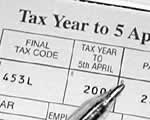 Go to main content
Go to main content
Archive Website of the UK government
Please note that this website has a UK government accesskeys system.
Main menu
Page menu
Money, tax and benefits

Check you're paying the right tax

Many people end up paying too much or too little Income Tax but don't understand why. So it's important to know how to check you're paying the right amount. This article tells you what to look for, where to find it and what to do if you find you're paying the wrong amount.
If you're an employee and/or you get a company pension
Your employer or pension provider uses your tax code to work out how much tax to take off your pay or pension. So if your tax code is wrong you could end up paying too much or too little tax.
Checking your tax code
You'll find your tax code on:
- your payslip
- your PAYE Coding Notice - you usually get this a couple of months before the start of the tax year and you may also get one if something has changed but not everyone needs to get one
- form P60 - you get this at the end of each tax year
- form P45 - you get this when you leave a job
If you're enrolled for Self Assessment Online, you can view PAYE Coding Notices issued on or after 11 October 2023 online.
Check that the different letters and numbers that make up your tax code are right. This is really important if you've got more than one job or source of income - or if you change jobs a lot.
If your tax code is wrong
You must tell HM Revenue & Customs (HMRC) as soon as possible so they can correct it. You may get some tax back - or you might have to pay a bit more.
If you get bank or building society interest
Your bank or building society takes tax off the interest from your savings before you get it.
It's a good idea to check with your bank or building society whether you should get tax-free interest on your savings and investments.
If you're self-employed and/or you fill in a Self Assessment tax return
You can fill in a Self Assessment tax return online or send HMRC a paper return by post.
Working out your Income Tax
If you fill in your tax return online you'll find out straight away how much tax you owe - or are owed back. If you fill in a paper return and send it to HMRC by 31 October following the end of the tax year they will work out your tax for you.
If you complete a paper return and it reaches HMRC after 31 October you'll have to pay a penalty for sending it in late and you may have to work out your own tax. If you file online your tax is worked out automatically and the latest filing deadline is 31 January.
Checking your tax calculation statement and Statement of Account
If you fill in a paper tax return, HMRC will send you a tax calculation statement. This tells you what tax you owe - or are owed back - and how it's been worked out. Check this and let them know straight away if you think it's wrong.
HMRC will also send you a demand for payment, called a Statement of Account, shortly before you're due to pay any tax.
If you send HMRC a paper tax return after 31 October you'll have to pay any tax you owe by the due dates - even if you haven't had a statement yet.
Telling HMRC about changes that might affect your Income Tax
Let HMRC know immediately about any changes in your circumstances. If you don't, you could end up paying the wrong amount of tax.
For example, you'll need to tell them if you:
- get married or form a civil partnership - and one of you was born before 1935
- start getting a second income
- become - or stop being - self-employed
- start getting company benefits - like a company car or health insurance
- start getting the State Pension
Record keeping
It's important to keep information and paperwork about your tax and income, like:
- payslips
- Statements of Account
- PAYE Coding Notices
- bank statements
- dividend vouchers
You may need to check these if you have any questions in the future or you want to make sure you're paying the right tax.
Income Tax - quick check calculator
If you're aged under 65, a basic or higher rate taxpayer - 20 or 40 per cent - and you get the basic Personal Allowance, you can use HMRC’s simple tax checker. It'll help you to find out if you're paying about the right amount of tax.
You'll need to have ready details of:
- your total earnings for the tax year before tax was taken off
- the total tax you paid on your earnings
- the amount of interest you had from bank and building society savings after tax was taken off
- the total tax you paid on bank and building society savings
- the total amount of any Gift Aid donations you've made
The tax checker will only give you an estimate. You might get other types of income, allowances or benefits that affect the amount of tax you end up paying.
How to correct mistakes
There are different ways of claiming tax back. It depends on whether you fill in a tax return and which year you're claiming for.
If you've paid too little tax HMRC will write to you and explain why it's happened and what to do.
 Facebook
Facebook Twitter
Twitter StumbleUpon
StumbleUpon Delicious
Delicious Reddit
Reddit